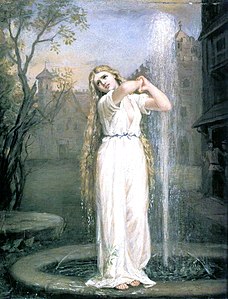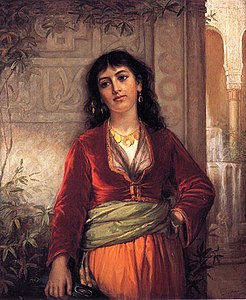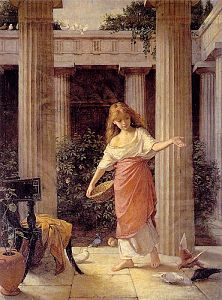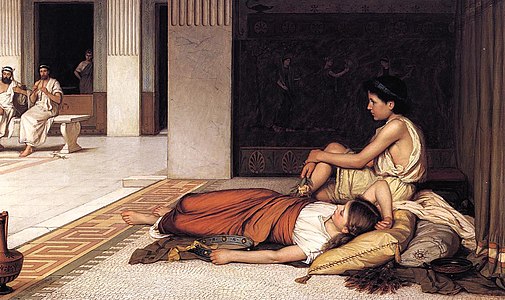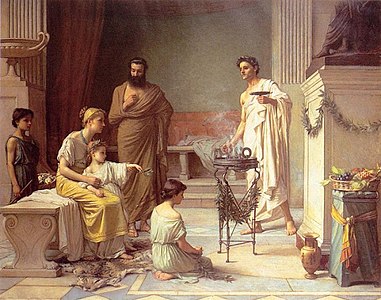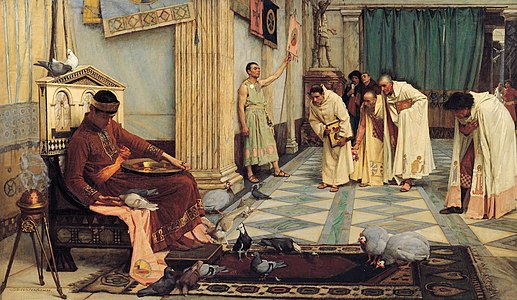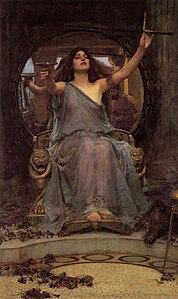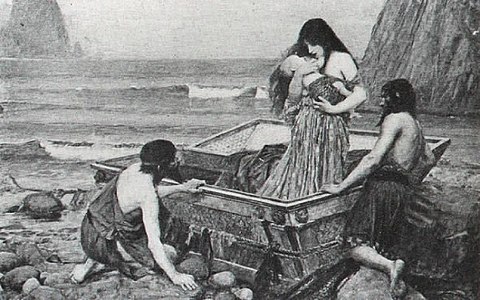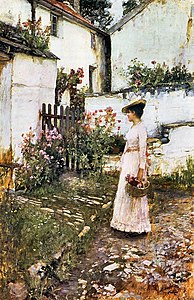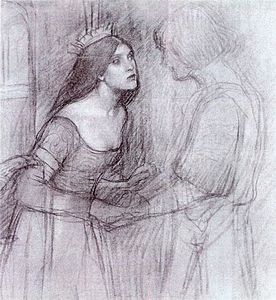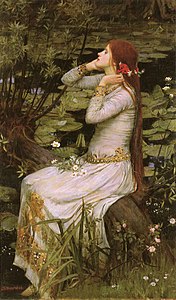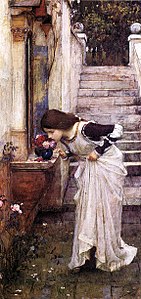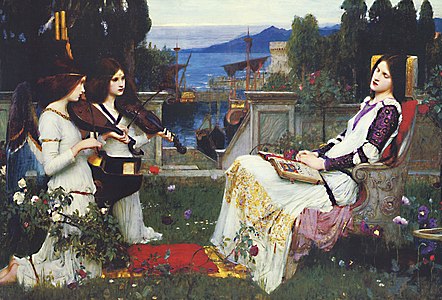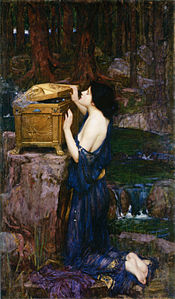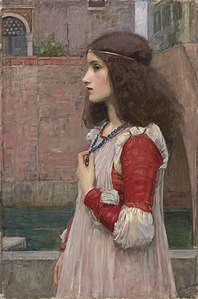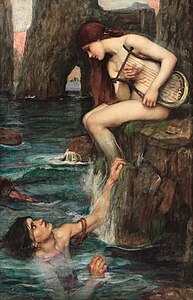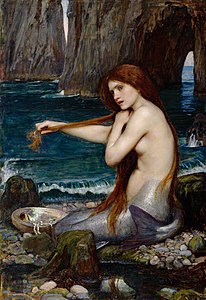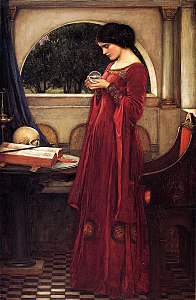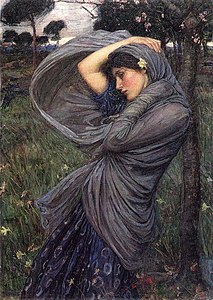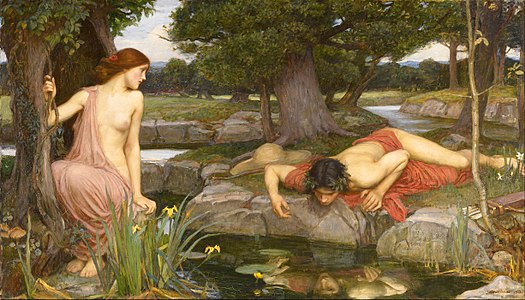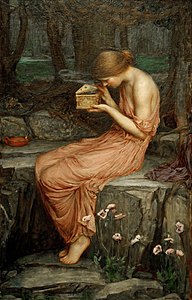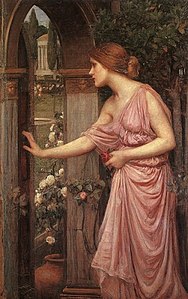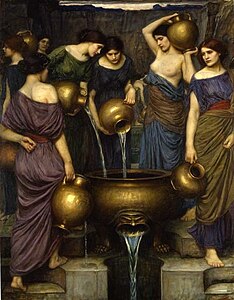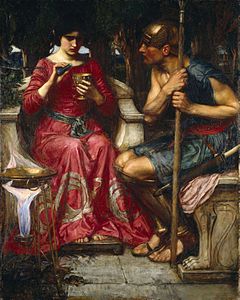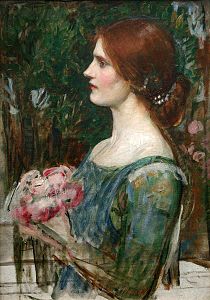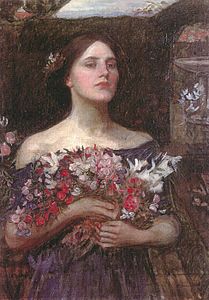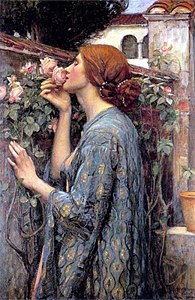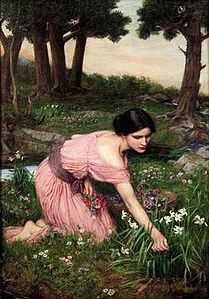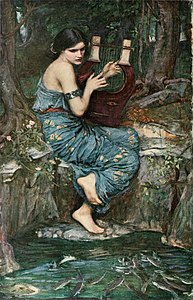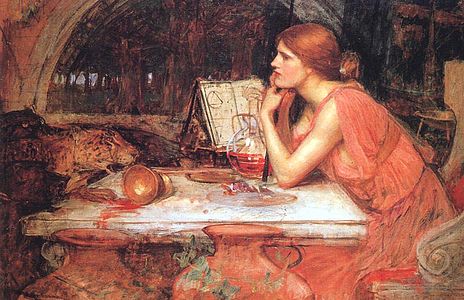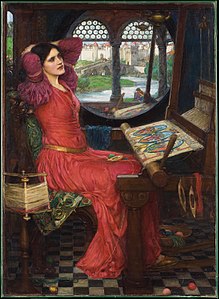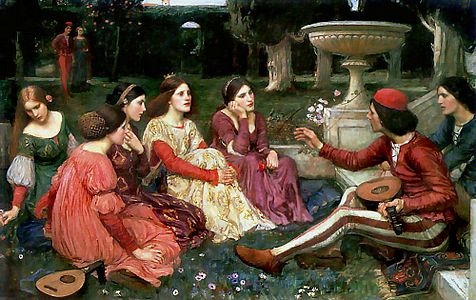John William Waterhouse
John William Waterhouse | |
|---|---|
| Movement | Pre-Raphaelite |
| Spouse | Esther Kenworthy Waterhouse |
John William Waterhouse
Born in
Waterhouse's work is displayed in many major art museums and galleries, and the
Biography
Early life
Waterhouse was born in the city of Rome to the English painters William and Isabella Waterhouse in 1849, in the same year that the members of the Pre-Raphaelite Brotherhood, including Dante Gabriel Rossetti, John Everett Millais and William Holman Hunt, were first causing a stir in the London art scene.[3] The exact date of his birth is unknown, though he was baptised on 6 April, and the later scholar of Waterhouse's work, Peter Trippi, believed that he was born between 1 and 23 January.[1] His early life in Italy has been cited as one of the reasons many of his later paintings were set in ancient Rome or based upon scenes taken from Roman mythology.
In 1854, the Waterhouses returned to England and moved to a newly built house in South Kensington, London, which was near to the newly founded Victoria and Albert Museum. Waterhouse, or 'Nino' as he was nicknamed, coming from an artistic family, was encouraged to become involved in drawing, and often sketched artworks that he found in the British Museum and the National Gallery.[4] In 1871, he entered the Royal Academy of Art school, initially to study sculpture, before moving on to painting.
Early career
Waterhouse's early works were not Pre-Raphaelite in nature, but were of classical themes in the spirit of
Later career
In 1883, Waterhouse married
One of Waterhouse's best known subjects is

He submitted his 1888 Ophelia painting in order to receive his diploma from the Royal Academy. (He had originally wanted to submit a painting titled A Mermaid, but it was not completed in time.) After this, the painting was lost until the 20th century. It is now displayed in the collection of Lord Lloyd-Webber. Waterhouse would paint Ophelia again in 1894 and 1909 or 1910, and he planned another painting in the series, called Ophelia in the Churchyard.
Waterhouse could not finish the series of Ophelia paintings because he was gravely ill with cancer by 1915. He died two years later, and his grave can be found at Kensal Green Cemetery in London.[6]
Gallery
In total, he produced 118 paintings. See List of paintings by John William Waterhouse for an almost complete list.
1870s
-
Undine
1872 -
Gone, But Not Forgotten
1873 -
La Fileuse
1874 -
In the Peristyle
1874 -
Miranda
1875 -
After the Dance
1876 -
A Sick Child brought into the Temple of Aesculapius
1877 -
The Remorse of the Emperor Nero after the Murder of his Mother
1878
1880s
-
Dolce far Niente
1880 -
Diogenes
1882 -
Saint Eulalia
1885 -
The Magic Circle
1886 -
Mariamne Leaving the Judgement Seat of Herod
1887 -
Cleopatra
1888 -
Ophelia
1889
1890s
-
A Roman Offering
1890 -
Danaë
1892 -
Circe Invidiosa
1892 -
Gathering Summer Flowers in a Devonshire Garden
1892-1893 -
A Female Study
1894 -
Ophelia
1894 -
The Shrine
1895 -
Saint Cecilia
1895 -
Pandora
1896 -
Juliet
1898 -
Ariadne
1898
1900s
-
The Siren
1900 -
Destiny
1900 -
The Lady Clare
1900 -
Study for Nymphs Finding the Head of Orpheus
1900 -
Nymphs Finding the Head of Orpheus
1900 -
The Mermaid
1901 -
The Crystal Ball
1902 -
The Missal
1902 -
Windflowers
1902 -
Boreas
1903 -
Psyche Opening the Golden Box
1903 -
Psyche Opening the Door into Cupid's Garden
1904 -
The Danaides, 1906
-
Jason and Medea
1907 -
Isabella and the pot of basil
1907 -
The Bouquet
(a study)
1908 -
Gather Ye Rosebuds or Ophelia (a study)
c. 1908 -
The Soul of the Rose or My Sweet Rose
1908 -
Lamia
(version 2)
1909 -
Thisbe
1909
1910s
-
Ophelia
1910 -
Spring Spreads One Green Lap of Flowers
1910 -
The Charmer
1911 -
The Sorceress
c. 1911-1915 -
Penelope and the Suitors
1912 -
The Annunciation
1914 -
Dante and Matilda (study) (formerly called "Dante and Beatrice")
c. 1914–17 -
Matilda (study) (formerly called "Beatrice")
c. 1915 -
I am Half-Sick of Shadows, said the Lady of Shalott
1916 -
A Tale from the Decameron
1916 -
Miranda – The Tempest
1916 -
Tristan and Isolde
1916
References
Notes
- ^ a b Trippi 2002, p. 9.
- ^ Severino, Carlos Mesquita (2019). Representações das Metamorphoses de Ovídio em J. W. Waterhouse (masterThesis). Lisboa: Faculdade de Letras da Universidade de Lisboa.
- ^ Trippi 2002, p. 4.
- ^ Trippi 2002, p. 14.
- ^ a b Trippi, Peter; Prettejohn, Elizabeth; Upstone, Robert. J.M. Waterhouse: The Modern Pre-Raphaelite Gallery Guide. The Royal Academy of Art. 2009.
- ^ J.W. Waterhouse and the Magic of Color
Bibliography
- ISBN 9780714842325.
Further reading
- Baldry, A. Lys (January 1895), J. W. Waterhouse and his Work, vol. 4, pp. 103–115
- Bénézit, E (2006). "Waterhouse, John William". Dictionary of Artists. Vol. 14. Paris: Gründ. pp. 668–669.
- Dorment, Richard (29 June 2009), "Waterhouse: The modern Pre-Raphaelite, at the Royal Academy – review", The Daily Telegraph
- Gunzburg, Darrelyn (2010). "John William Waterhouse, Beyond the Modern Pre-Raphaelite". The Art Book. 17 (2): 70–72. ISSN 1368-6267.
- Hobson, Anthony (1980). The Art and Life of J.W. Waterhouse, RA, 1849-1917. Rizzoli. ISBN 978-0-8478-0324-8.
- Moyle, Franny (13 June 2009), "Pre-Raphaelite art: the paintings that obsessed the Victorians [print version: Sex and death: The paintings that obsessed the Victorians]", The Daily Telegraph (Review), pp. R2–R3.
- Simpson, Eileen (17 June 2009), "Pre-Raphaelites for a new generation: Letters, 17 June: Pre-Raphaelite revival", The Daily Telegraph.
- Cartwright, Rob (2021), TURNING THE LIGHT ON J.W. WATERHOUSE, RA – A BIOGRAPHY
External links
- John William Waterhouse.net
- John William Waterhouse (The Art and Life of JW Waterhouse) Archived 14 February 2020 at the Wayback Machine;
- John William Waterhouse (Comprehensive Painting Gallery)
- John William Waterhouse (1849–1917)
- John William Waterhouse Style and Technique
- Waterhouse at Tate Britain
- Echo and Narcissus (1903)
- Ten Dreams Galleries
- John William Waterhouse in the "History of Art"
- Profile on Royal Academy of Arts Collections
- 25 artworks by or after John William Waterhouse at the Art UK site
- Portraits of John William Waterhouse at the National Portrait Gallery, London
- Trippi, Peter. "Waterhouse, John William (1849–1917)". doi:10.1093/ref:odnb/38885. (Subscription or UK public library membershiprequired.)
- "Waterhouse, John William". Who's Who. A & C Black. (Subscription or UK public library membership required.)
- John William Waterhouse at Library of Congress, with 2 library catalogue records
- Findagrave burial record

